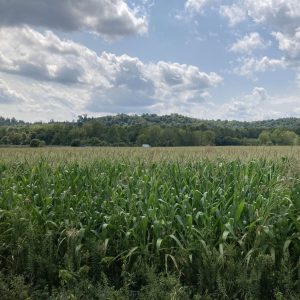August 2025: Driest August Ever Recorded for Athens County
Alex Akpofure, Lexi Belpulsi, Emma Edwardson, Bailey Schaaf, and Rebecca Mitten

Introduction
Athens is no stranger to dry weather in the late summer and fall seasons. Last year, the county experienced exceptional drought conditions that brought significant agricultural and ecological impacts to the region. Luckily, this year has not been as dry as last year’s drought. However, there was one notable record broken: August 2025 was the driest August month on record for Athens County. Using data from the Scalia Laboratory weather tower, CoCoRaHS Data Explorer, USA Drought Monitor, and the Climate Prediction Center, this article breaks down how this year’s August compares to other years historically and explains how conditions remained so dry throughout the month.
Past Conditions
Over the past few years, Athens, OH has been seeing a downward trend in total August rainfall. Based on data from CoCoRaHS Data Explorer, the average total rainfall between the years of 2017 and 2022 was 4.05 inches; from 2017 to 2023, the Scalia Laboratory weather tower observed an average total rainfall of 3.22 inches in the month of August. 2021 saw above-average rainfall totals due to remnants of a tropical storm that sat over Athens County, allowing for a day of continuous rainfall. Otherwise, the monthly totals ranged from around 2.30 inches to 3.00 inches, visualized with Figure 1.

Figure 1. A line graph showing the changes in total rainfall from 2017-2023 gathered by the Scalia Weather Tower.
Between August of 2024 and 2025, the Scalia weather tower received the lowest total rainfalls on record; 2024 achieved the fourth lowest with 0.90 inches, and 2025 achieved a record breaking low of 0.33 inches of total rainfall for the county according to CoCoRaHs Data Explorer. August of 2024, as compared to all total rainfalls on record, was 77.67% below average, and August of 2025 was 91.80% below average for the county. Table 1 displays these data points.
Table 1:
| DATE | TOTAL RAINFALL | (ATHENS CO.) % BELOW AVERAGE |
| August 2024 | 0.90 in. | 77.67 % |
| August 2025 | 0.33 in. | 91.80 % |
This year’s dry patterns have been influenced by an abundance of high pressure and upper-level ridging. Due to these conditions, there was an overall deficiency of opportunity for showers and thunderstorms to develop for the majority of the month, as well as a lack of widespread precipitation-inducing frontal systems. While our region did see a fair share of cold fronts entering and exiting the area, very few brought much, if any, precipitation. A huge component for this was caused by an omega block towards the second half of the month centered in the Midwest, keeping an abundance of high pressure and preventing weather systems from directly affecting the Athens area.
These lower precipitation totals have also influenced an increase in drought conditions. During 2024 and 2025, the drought level in Athens and throughout other places in Ohio greatly increased during and after the month of August due to the lack of rainfall. August 2023 and the years before that, however, was impacted by the drought to a much lesser extent at the end of August because of greater precipitation.

The top row depicts Athens’s drought conditions at the beginning of August in 2023, 2024, and 2025. The bottom row depicts our drought conditions at the beginning of September for all of those years. All photos received from the U.S. Drought Monitor Time Series
A difference can be seen between our drought conditions in 2024 and 2025. Even though Athens County has received less rainfall this August than last year, our drought conditions aren’t nearly as severe. This is due to July receiving 8.72 inches of rain, whereas in 2024 July received 2.26 inches according to CoCoRaHS Data Explorer. The Scalia weather tower recorded over 11 inches of rain for July in 2025 as well.
August Conditions
Conditions for August remained sunny and uneventful, which is what resulted in exceptionally dry conditions for the month. For most of the month, prolonged ridging patterns would cover Ohio and much of the eastern United States. This, combined with broad areas of high pressure at the surface, would force the region to stay dry and hot. These high-pressure systems discourage vertical development, making it difficult for clouds to form throughout the atmosphere.
Despite a few cold fronts occasionally moving through the area with clouds and minor precipitation, multiple dry air masses would completely take over the few days of rain; this dry air aloft defined the majority of August. Most of the moisture that reached our region would simply evaporate back into the atmosphere from this dry air. An omega block pattern also prevented lower pressure from moving into the region. If lower pressure had been allowed to move through the Ohio Valley, there would have been a possibility that these dry air masses would not have persisted, which would have allowed for moisture and vertical development to theoretically create rain showers that would have increased the monthly precipitation total for August. Omega blocks are well-known to be quite persistent and stationary due to the changes in atmospheric forcing that stall their motion; these extended dry spell periods under the ridge in the omega block would then create a continuous positive feedback loop of more major ridging patterns and high-pressure at the surface, which continued to reject cloud development and subsequent rainfall events. The omega block would cause these synoptic patterns to sit over the state for days to almost weeks at a time with hardly any movement from the eastern half of the United States.
Future Conditions
Looking ahead at the rest of the fall season into the beginning of winter, drought conditions are expected to persist. Despite August being very dry, as of October 2nd, the US Drought Monitor currently has Athens County at a D0 Drought Level (Abnormally Dry, or Level ⅕). The Climate Prediction Center currently has forecasted Athens to receive near normal precipitation amounts for the first couple weeks in October with the third week of the month having below normal precipitation amounts followed by near normal amounts to end the month. This is a pattern that is continuing from our unusually dry August, hence why the Climate Prediction Center has forecasted that drought conditions will persist through the end of the fall season.

Figure 3. This map shows the drought outlook conditions for the US for the rest of the 2025 year.
However, there is some hope as even though conditions will stay mostly dry, the U.S. Drought Monitor putting Athens County within D0 (level ⅕) conditions can be assumed to be due to the fact that we received some rain at the end of September along with the lasting effects from the high amount of rain received in July. Our current conditions, added to the fact that future precipitation is only expected to be mildly drier than normal and the Climate Prediction Center stating that current conditions are expected to persist, indicates that we should remain within mild drought conditions and won’t reach exceptional levels like we did in the fall season of 2024. August 2025 may have been the driest August yet for Athens County, but its worst and long-term effects have fortunately been mostly mitigated.

Figure 4. Above are maps that show the precipitation outlook for the first few weeks of October, the middle of October, and the end of October
Conclusion
August 2025 was the driest August on record for Athens County. This was due to persistent weather patterns in the region that kept high pressure and dry air in place to create positive feedback loops that resulted in almost no precipitation throughout the entire month. These weather patterns contributed to the drought conditions for Athens County; however, the worst effects were mitigated due to a very wet July and a break in the dry conditions in September with the showers and storms we experienced for a few days near the end of the month. It was still a notable, record-breaking month for August, and another notable event given the history of drought for this time of year in Athens. If you would like to hear more about Athens’ history with droughts, feel free to check out this article where our Lab Director, Dr. Ryan Fogt, discusses previous instances of drought, and gives some further explanation as to why this past August was so dry.

